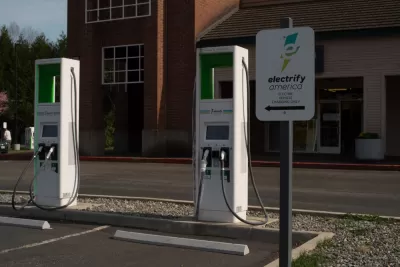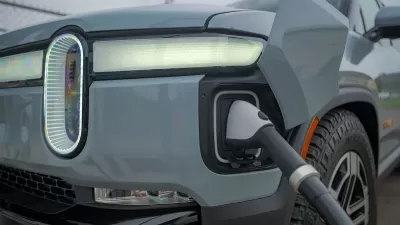Volkswagen-owned Electrify America plans to make its new charging stations more user-friendly with solar panel awnings and waiting lounges.

"Charging an electric car isn’t as straightforward as refilling a gas tank. Recharging times can vary depending on the vehicle type and power source. Battery experts claim that charging times will eventually shrink to around 10 minutes, but not for years to come."
To improve the experience, writes Andrew J. Hawkins in The Verge, Volkswagen's Electrify America charging company "aims to make charging as comfortable and seamless as possible" by installing "human-centered stations" in several California cities and New York. The stations will feature awnings with solar panels and a waiting area.
"The company’s new stations are organized around comfort, security, and amenities, with a nod toward the length of time it takes to recharge an EV," according to Hawkins. "The most notable change for Electrify America’s current design is the inclusion of solar panel awnings, which have the dual effect of sheltering customers from the sun and inclement weather while also supplying power for the station’s operations."
As Hawkins writes, "The charging experience in the US is extremely fragmented, especially for people who don’t own a Tesla. While Tesla’s Supercharger network has been praised for its seamless user experience and fast charging ability, the opposite appears to be true for pretty much everyone else." But EV proponents see hope in the Biden administration's $5 billion investment in EV chargers. "Experts in urban policy and electrification have said that the money authorized for a nationwide network of EV chargers would have a measurable impact on Americans’ car-buying choices," making it possible for more Americans to make the switch.
FULL STORY: VW’s Electrify America unveils new ‘human-centered’ EV charging stations

Alabama: Trump Terminates Settlements for Black Communities Harmed By Raw Sewage
Trump deemed the landmark civil rights agreement “illegal DEI and environmental justice policy.”

Planetizen Federal Action Tracker
A weekly monitor of how Trump’s orders and actions are impacting planners and planning in America.

The 120 Year Old Tiny Home Villages That Sheltered San Francisco’s Earthquake Refugees
More than a century ago, San Francisco mobilized to house thousands of residents displaced by the 1906 earthquake. Could their strategy offer a model for the present?

Ken Jennings Launches Transit Web Series
The Jeopardy champ wants you to ride public transit.

BLM To Rescind Public Lands Rule
The change will downgrade conservation, once again putting federal land at risk for mining and other extractive uses.

Indy Neighborhood Group Builds Temporary Multi-Use Path
Community members, aided in part by funding from the city, repurposed a vehicle lane to create a protected bike and pedestrian path for the summer season.
Urban Design for Planners 1: Software Tools
This six-course series explores essential urban design concepts using open source software and equips planners with the tools they need to participate fully in the urban design process.
Planning for Universal Design
Learn the tools for implementing Universal Design in planning regulations.
Clanton & Associates, Inc.
Jessamine County Fiscal Court
Institute for Housing and Urban Development Studies (IHS)
City of Grandview
Harvard GSD Executive Education
Toledo-Lucas County Plan Commissions
Salt Lake City
NYU Wagner Graduate School of Public Service





























